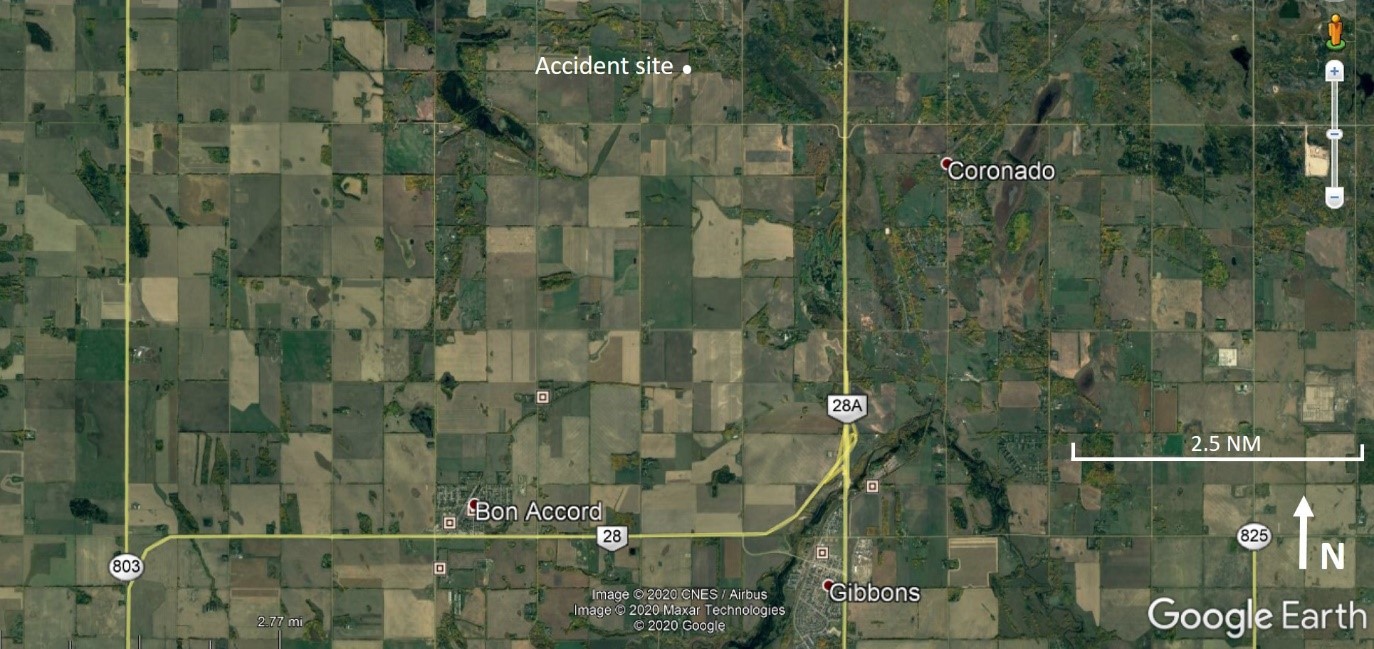Loss of control and collision with terrain
RS Ultra Kangook MF powered paraglider (basic ultralight), C-ILQJ
Gibbons, Alberta, 4.5 NM NW
The Transportation Safety Board of Canada (TSB) investigated this occurrence for the purpose of advancing transportation safety. It is not the function of the Board to assign fault or determine civil or criminal liability. This report is not created for use in the context of legal, disciplinary or other proceedings. See Ownership and use of content. Masculine pronouns and position titles may be used to signify all genders to comply with the Canadian Transportation Accident Investigation and Safety Board Act (S.C. 1989, c. 3).
History of the flight
On 13 May 2020, the RS Ultra Kangook MF powered paraglider (registration C-ILQJ, serial number 463) was conducting a local recreational flight from a private field 4.5 nautical miles (NM) northwest of Gibbons, Alberta (Figure 1).
The occurrence flight was the pilot’s 2nd flight of the season and of that week. The pilot completed the pre-flight inspection on the occurrence aircraft and, at approximately 1715,Footnote 1 departed the field in a southeasterly direction. The pilot flew locally within 1 NM of the field for approximately 25 minutes. The entire flight was captured on an action video camera attached to the pilot’s helmet, and the recording was used extensively by the investigation.
One minute before the accident, the pilot performed an approach to the take-off area in a southeasterly direction. Just before touchdown, power was applied and a go-around to the south was commenced. When it was approximately 75 feet above ground level, the aircraft flew through a dust devil (Figure 2). Without input from the pilot, the aircraft’s climb rate suddenly increased, the aircraft rolled sharply to the right, and the paraglider lines wrapped around the pilot, the trike, and the turning propeller, eventually collapsing the entire canopy. At approximately 1745, control was lost and the aircraft impacted the ground, fatally injuring the pilot.
Aircraft information
The RS Ultra Kangook MF is a powered paraglider (Figure 3). The occurrence aircraft was registered with Transport Canada as a basic ultralight and was equipped with an APCO Vista HP S canopy.Footnote 2
A post-accident examination of the canopy, suspension and control lines, trike, and engine were completed. No anomalies were found that would have contributed to the loss of control.
Pilot information
The pilot held a pilot permit – ultra-light aeroplane that was restricted to powered parachutes only. He was issued the permit by Transport Canada on 02 December 2019, after completing his training during the summer of 2019. During his training, he had completed 20 hours of ground school, 10 hours of solo flying, and 49 takeoffs and landings, including normal and emergency manoeuvres. The pilot had carried out his training on the occurrence aircraft. The investigation could not determine the total number of paraglider flying hours the pilot had.
The training manual for paraglidingFootnote 3 used for the pilot’s training discussed dust devils and other adverse weather conditions but the extent to which the pilot knew about dust devils could not be determined.
Weather information
The weather conditions immediately before and after the occurrence flight were consistent with visual meteorological conditions.
The closest aerodrome forecasts (TAFs) and aerodrome routine meteorological reports (METARs) that were available for planning purposes before the flight were from Edmonton/Namao Heliport (CYED), Alberta, located at CFB Edmonton, approximately 16.4 NM south-southwest of the accident site. The TAF for CYED, valid from 1200 on 13 May 2020 until 0000 on 14 May 2020, was as follows:
- wind variable at 3 knots,
- visibility greater than 6 statute miles,
- few clouds based at 8000 feet above ground level.
The hourly METAR for CYED, taken 15 minutes after the time of the accident, indicated the following:
- wind 160° true (T) at 2 knots,
- visibility 9 statute miles,
- clear skies,
- temperature 15 °C, dew point −5 °C.
A windsock located on the fence line at the south end of the field being used for operations was observed at various times in the video recording of the 25-minute flight. The wind direction was variable, ranging from 135°T to 285°T. Wind velocity was harder to establish as the wind sock was not a standard aviation type. When fully extended, the windsock represents a minimum wind speed of about 5 knots. During the occurrence flight, the windsock was fully extended most of the time when it came into view in the video.
Dust devils
Dust devils are common in Alberta and are more prevalent during warm sunny days with low ambient humidity, where localized heating occurs in dry bare soil. In such conditions, localized rotating updrafts may be created and are only visible if there is loose material on the ground to highlight it, such as dust, sand, straw, or snow. Environment and Climate Change Canada defines dust devils as follows:
Normally harmless, dust devils are rotating updrafts or eddies that typically form on hot sunny days when strong surface heating causes the air adjacent to the ground to heat up as well. This localized pocket of hot air rises quickly in a small spinning column, and cooler air rushes in below to replace it. The resulting vortex is made visible by the dust it picks up. Dust devils seldom extend higher than 100 metres, but those that do can flip objects like lawn furniture.Footnote 4
Safety message
Encountering meteorological events such as dust devils can present a significant hazard to paraglider operations. Paraglider pilots need to be aware of the conditions that can be conducive to the formation of these phenomena, and avoid operating in these conditions where possible.
This report concludes the Transportation Safety Board of Canada’s investigation into this occurrence. The Board authorized the release of this report on . It was officially released on .


